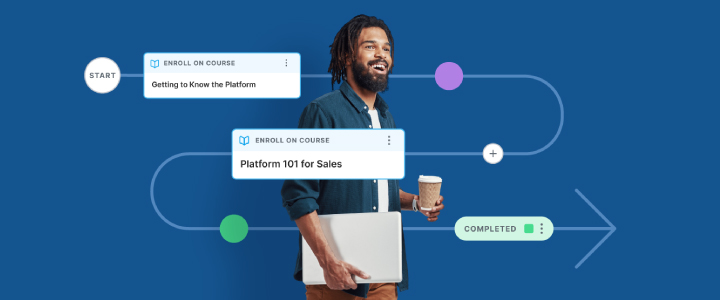
4 min reading time
What is Microlearning?
Among recent trends in the world of online education, one that has continued to gain popularity is microlearning. If planned and executed correctly, microlearning can be a powerful strategy to meet your team’s learning goals.
In this blog post, we’ll provide an overview of microlearning, where it succeeds, where it falls short, and tips to make the most of this increasingly popular approach.
What is microlearning?
In short, microlearning is all about adapting to modern content consumption habits. With so many of us spending hours a day browsing social media feeds and short blog posts, microlearning embraces brevity to deliver quick, easy-to-digest lessons that can be consumed whenever it’s convenient to the learner.
With the in-person learning vs. online learning discussion being a hot topic among L&D professionals, microlearning can be a convincing reason to opt in favor of online learning and development platforms. While microlearning can technically be accomplished in person, the functionality and rich media offered online are perfect for the strategy.
It’s worth mentioning that microlearning isn’t as simple as just cutting up a longer lesson into smaller pieces. While this approach can technically touch on some of the benefits, it’s much more effective to design lessons with microlearning in mind, rather than attempting to shoehorn longform content into smaller pieces through simple copying and pasting.
The benefits of microlearning
Beyond aligning with modern content consumption behaviors, there are several other benefits to embracing microlearning within your overall L&D strategy:
- Easy to deliver: With the right tools, creating these bite-sized training courses can be quick and simple, saving you hours that could have previously been spent planning and delivering in-person training.
- Increased retention: Existing studies show the power of “chunking”, or grouping information into small, interrelated “chunks.” This technique has been shown to convincingly increase retention over time.
- Flexibility: Because microlearning units typically require just a couple of minutes each, learners can fit them into their day whenever it’s convenient. This not only increases efficiency, but also removes the need to deprioritize work duties for a significant portion of the day.
Boosts engagement and learner satisfaction: Learners love microlearning because it isn’t overwhelming and allows them to choose the medium that they best connect with. And because they retain more information without prolonged focus, they are more likely to come away from the experience feeling like it was efficient and worthwhile.
The challenges of microlearning
- Tougher to teach complex topics: Some subjects just aren’t made for breaking up into little pieces. Microlearning can still be a good reinforcement mechanism for topics that require more time and energy to learn. But the approach might fall short of providing a satisfactory introduction to a multilayered, complex topic.
- More work for the L&D team: Building an effective microlearning strategy requires a lot of organization as it can result in dozens of separate learning modules. This requires a modern, intuitive learning and development platform. This also means that L&D teams must coordinate their efforts in order to reduce the likelihood of duplicate efforts or a confusing learner experience.
Not ideal for in-person learning: As your L&D team has weighed in-person learning vs. online learning, you may have decided that certain topics or learning goals are best achieved in a physical classroom. While microlearning can still play a role in helping reinforce in-person learning, it’s probably not ideal as the sole strategy if that’s the route you’ve decided to go.
Microlearning examples
While there are a lot of different formats that could be classified under microlearning, here are a few suggestions to help get you started:
- Microlearning videos: Short, focused videos that are designed to meet specific learning objectives. They can be standalone nuggets of training content, such as explainer videos or whiteboard animations.
- Microcopy: Easy-to-scan, contextualized, short messages to help users learn.
- A short, podcast-like audio clip with an expert explaining a concept.
- Interactive elements such as quizzes, games, flashcards, and other forms of game-based learning. It could include awards, a badge or another incentive like achieving a high score on a leaderboard.
Infographics can be used to convey complex information quickly and clearly using visual representations of information, data, or knowledge.
Tips to make the most of microlearning
- Include different forms of multimedia: As we outlined above, microlearning can take many different forms, and we encourage you to embrace as many as possible. Not only does this add variety, but it gives learners the opportunity to consume course material in the format that best connects with their preferred learning style.
- Collect feedback: As always, make sure to collect learner feedback via a training evaluation form and update the evaluation often to ensure it consists of the most effective training survey questions. Once you’ve collected feedback, use it to evolve your microlearning strategy over time.
Include gamification: Gamification can be effective across a range of learning strategies, but it really shines within a microlearning environment. Because modules are already broken up into small pieces, it’s easier to track progress across learners, and the inclusion of games and quizzes makes leaderboards a natural extension of the microlearning experience.
Conclusion
Microlearning isn’t going away, and will likely get more popular over time. Given the many benefits that microlearning offers, including increased learner satisfaction and better retention, it makes sense to include microlearning within your overall L&D strategy. Once you start experimenting with it, we’re willing to bet that you’ll soon become an advocate as well.



